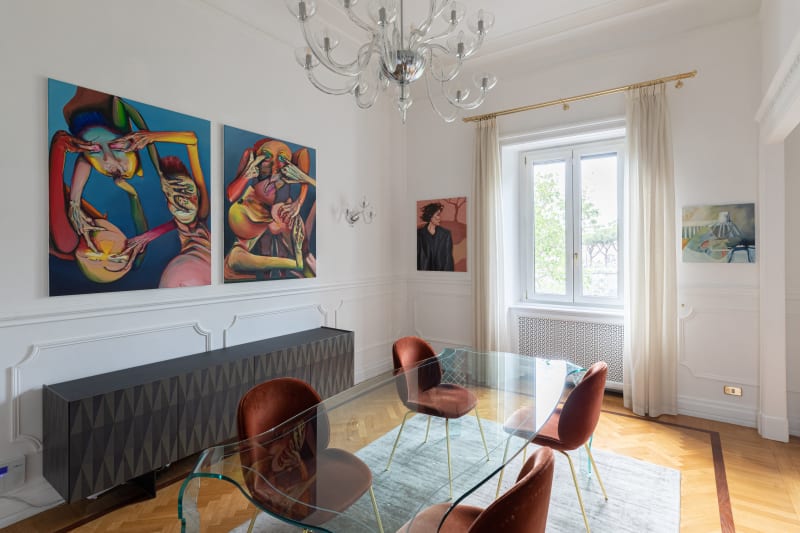She Came to Stay
Bambou Gili, Emma Cousin, Nadia Waheed, Lucile Littot, Krista Louise Smith, Sola Olulode, Zofia Pałucha, Astrid Terrazas, Ania Hobson, Hélène Padoux, Mary Stephenson, Xiuching Tsay, Paula Kamps, Lise Stoufflet, Sara Rahmanian, Nicolette Mishkan, Elizabeth Jaeger, Rewind Collective.
Curated by Domenico de Chirico
The exhibition She Came to Stay borrows its title from Simone de Beauvoir’s groundbreaking debut novel, first published in 1943. The book, a semi-autobiographical exploration of a love triangle (ménage à trois), delves into complex psychological dynamics, freedom, and existential responsibility, as individuals are forced to see themselves through the eyes of the Other.
More than just a narrative on romantic entanglement, Beauvoir’s novel laid the groundwork for her lifelong examination of the human condition, especially that of women, through the lens of existentialist thought. Deeply influenced by Martin Heidegger, she wrote: “Existing is daring to throw oneself into the world.” For Beauvoir, time was central to existence—life becomes an act of resistance against its passage, and the present is the stage for action and choice. Freedom, in her philosophy, is an ambiguous condition: we are both subjects and objects, constantly navigating a space of possibility and constraint.
Taking its cue from these existential themes, She Came to Stay brings together a diverse group of contemporary female artists and collectives, reflecting on identity, transformation, autonomy, and embodiment. These artists do not approach painting (and related practices) as escapism, but rather as an active, conscious insertion into the messy complexities of reality—Being, here, is a verb of intention, not passivity.
The Artists
Bambou Gili creates enigmatic scenes populated by long-limbed figures and mysterious female faces. Her brushwork—alternating between ethereal cerulean tones and assertive strokes—builds tension that feels at once casual and unsettling.
Emma Cousin combines dark humor and irreverence to dissect the tensions embedded in contemporary norms. Her female characters navigate complex metaphors, questioning the stability of language, meaning, and gendered expectation.
Nadia Waheed produces autobiographical works with precision and bold color. Themes of identity, diversity, and cultural integration run through her work, deeply rooted in her experience as a woman of color.
Lucile Littot animates archetypes drawn from personal mythology, pop culture, and cinema history. Her porcelain sculptures, videos, and performances are infused with rococo decadence, feminine melancholy, and a deliberate blurring of fiction and reality.
Krista Louise Smith employs semitransparent oils and intuitively drawn lines to explore physical, emotional, and spiritual experiences. Her lightness is deceptive—within it lies catharsis, reflection, and healing.
Sola Olulode celebrates Black identity, unity, and intimacy. Her dreamlike paintings dissolve spatial boundaries, creating “anti-spaces” where movement, gesture, and community flourish outside rigid identity frameworks.
Zofia Pałucha uses painting to push against cultural stagnation and nationalism. Her works—rich in references to digital life, mass media, and societal anxiety—speak of a rebellion against banality and a longing for visionary imagination.
Astrid Terrazas draws from folklore, mysticism, and lived trauma to create paintings, ceramics, and sculptures as talismanic artifacts. Her art serves as both storytelling and spiritual protection.
Ania Hobson captures intimate moments—conversations in cars, bars, and bedrooms—with bold color and piercing expressions. Her paintings teeter between the mundane and the surreal, revealing the emotional undercurrents of daily life.
Hélène Padoux explores emotional ambiguity and lost innocence through delicate yet toxic scenes. Her fruit and flower motifs evoke tenderness, vulnerability, and the simultaneous presence of exploitation and care.
Mary Stephenson creates surreal tableaux where objects behave like characters. Using humor and romanticism, she critiques consumerism, performative identity, and social anxiety through meticulously layered compositions.
Xiuching Tsay revives forgotten objects through visionary hallucination. Her work plays with water both materially and metaphorically, transforming memory into immersive, fluid spirituality.
Paula Kamps subverts traditional painting hierarchies. Her hybrid watercolor-drawing technique yields fragmented figures and memories, layering intimacy and disorientation across fluid surfaces.
Lise Stoufflet crafts narrative-rich yet ambiguous images. Her pastel-meets-saturated palette conjures dreamlike tension, suggesting untold stories that are seductive, strange, and faintly menacing.
Sara Rahmanian paints on unconventional surfaces—coffee filters, cloth—to interrogate the absurdity of modern life. Her first-person perspectives blend reality with imagination in contemplative, often humorous, ways.
Nicolette Mishkan invokes the myth of the mermaid as a symbol of seductive danger. Her work is both erotic and uncanny—fins as phallic and feminine, siren songs that lure and devour, cosmic balance ever on the brink.
Elizabeth Jaeger sculpts elongated bodies, dogs, empty vases, and domestic objects into existential reflections. Despite their familiarity, her works provoke discomfort, confronting viewers with the fragility of perception, presence, and identity.
Rewind Collective is a digital art group addressing inequality in the art world. By reinterpreting canonical works through feminist and inclusive lenses, they aim to “rewind” the systems of patriarchy and give visibility to the underrepresented.
In She Came to Stay, the artists do more than simply show up—they occupy space, reframe narratives, and challenge established identities. The exhibition becomes a shared arena of radical presence, where painting and sculpture are not ends in themselves, but means of engaging with the freedom and ambiguity of Being.





